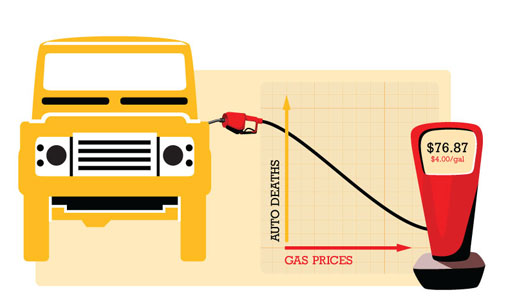Could Higher Costs Lower Auto Fatalities?
By Nicole Wyatt
|
|
The high price of cheap gas: Research by UAB's Michael Morrisey and others found that gas prices and auto fatalities seem to be inversely proportional. That is, as the price of gas rises, fewer people die on the roads. |
As gas prices rise, so do the tempers of many drivers. This spring, the average price of a gallon of unleaded gasoline rose nearly a dollar compared to a year ago. And even though prices have fallen slightly in the past few weeks, they are still close to record highs.
The news isn’t all bad, however. While the rising prices may make saving money difficult, they could help save lives by reducing the number of motor-vehicle fatalities. Michael Morrisey, Ph.D., director of UAB’s Lister Hill Center for Health Policy, helped shed light on the silver lining in a study with the UAB Injury Control Research Center. Just a ten-cent sustained increase in gas prices reduced motor-vehicle fatalities per capita by a total of 2.3 percent over two years, he says.
Less Blood on the Highway
“As careful as the enforcement of speeding and drunk-driving laws is, one thing that has changed over the last few years is that gas prices are higher,” Morrisey explains. “In turn, fewer people are on the roads, and drivers are combining trips. As a consequence, there’s less opportunity to have a crash and die.”
The opposite seemed to be true when Morrisey and his fellow researchers began studying gasoline prices. “We had seen evidence that many public-policy interventions were effective in reducing fatalities, but the trend in fatalities per capita wasn’t falling,” he says. “As economists, we looked for reasons that could explain that, and declining real gas prices in the late 1990s and early 2000s were an obvious candidate.”
Safety and the Price of Beer
Other hikes—in beer taxes and the unemployment rate—could also make a positive impact, Morrisey says. In a study of two decades of motor-vehicle crashes, he and other researchers noted that higher beer taxes correlated with fewer fatalities, most likely because the resulting rise in prices led to lower beer consumption and fewer instances of impaired driving. “For 18- to 20-year-old drivers, we found that a 10 percent increase in beer taxes reduces fatalities by about 1.5 percent, and the results are similar for 21- to 24-year-olds,” Morrisey explains.
Could states simply legislate their way to safety by increasing beer taxes? Morrisey says no. “There is certainly not enough of a reduction in fatalities to argue that states could have a major effect by raising beer taxes,” he explains. “These effects are not huge, but they are meaningful.”
A higher unemployment rate helps take vehicles off the road by reducing the amount of materials that are transported and the numbers of people driving to and from work, Morrisey says. “From the perspective of highway safety, the combination of high unemployment and high gas prices is a good thing. Virtually all of the dramatic reduction in motor-vehicle fatalities that we have seen in the last few years can be attributed to the combination of higher gas prices and the recession.”
Looking ahead to the rest of the year, Morrisey offers a mixed outlook on driving safety. “Gas prices may increase through the end of the year, depending on what happens in the Middle East,” he says, adding that disruptions caused by a hurricane also could prolong the pain at the pump. While that could lead to lower fatalities, Morrisey says, the improving economy will lead to more fatalities. “Increasing employment means there will be more people on the road, more congestion, more crashes, and more fatalities. Higher gas prices tend to make us safer, but the improving economy puts us at greater risk.”
